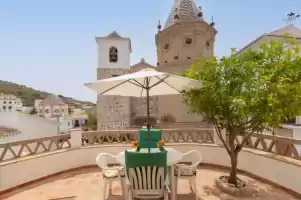Malaga, the jewel of the Costa del Sol, is not all about beaches, sun and sardine skewers. This city, rich in history and culture, hides an architectural heritage that rivals that of the great European cities. Among its greatest attractions are the Andalusian patios, spaces that fuse the Arab legacy with the most authentic Andalusian tradition.
Spring transforms these venues into spaces full of life and colour, where geraniums, bougainvillea and jasmine create an atmosphere with a very special combination of fragrances. In addition, the mild climate of this time of year will allow you to explore the city without the high temperatures of summer, while enjoying the many cultural events that take place around these unique spaces.
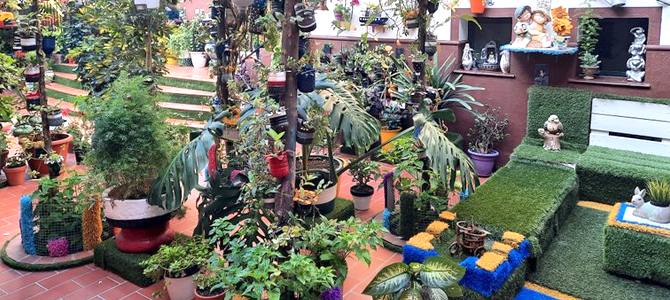
History and tradition of the patios of Malaga
Malaga’s patios have a strong Arab influence, a legacy of the eight centuries of Muslim presence in the Iberian Peninsula. During this period, the patios became fundamental elements of the houses, functioning as spaces for family and social coexistence, as well as providing light and natural ventilation to the houses.
Unlike the famous courtyards of Cordoba, those of Malaga tend to be more sober architecturally, but equally charming. While Cordoba’s patios are notable for their floral exuberance and their arrangement around a central pond, Malaga’s patios are characterised by a more austere elegance, with elements such as marble columns, hydraulic tile floors and tiled skirting boards.
Over the centuries, these spaces have evolved, adapting to the social and architectural changes of each era, but always maintaining their essence. Today you can find them both in the historic centre of the capital and in the picturesque white villages of the province, preserving their traditional character while integrating into modern life.
The Alcazaba of Malaga
If you want to understand the origin of Andalusian patios, there is no better starting point than the Alcazaba of Malaga. This imposing 11th century fortress, built during the Muslim period, is one of the city’s most representative monuments. In addition to its walls and towers, the Alcazaba is home to gardens and courtyards that are a real spectacle for the senses.
Strolling through its courtyards is like stepping back in time. Among almond trees, fig trees, bougainvillea and honeysuckle, you will discover how the vegetation intertwines with the Arab architecture, creating an atmosphere of calm and serenity. And best of all: admission is free on Sunday afternoons.
The Economic Society of Friends of the Country
Right in the centre of Malaga, in the Plaza de la Constitución, is one of the most charming and lesser-known courtyards in the city. The Sociedad Económica de Amigos del País, founded in the 18th century, is a cultural institution that houses a small Andalusian courtyard full of charm.
With its central fountain and aromatic plants, this courtyard will remind you of a religious cloister, but with a more intimate and cosy touch. The building also hosts exhibitions and talks, making it the perfect place to combine culture and relaxation. If you happen to be passing by, be sure to take a look at this hidden corner.
Courtyard of the Picasso Museum
The courtyard of the Buenavista Palace, home to the Picasso Museum, is one of the most representative examples of traditional Malaga architecture. This 16th-century Renaissance space, with its marble columns and upper gallery, will transport you to another era.
In addition to enjoying the courtyard as part of the architectural tour of the museum, you can immerse yourself in the work of the most universal Malaga artist: Pablo Picasso. The combination of contemporary art and historical tradition makes this visit unforgettable.
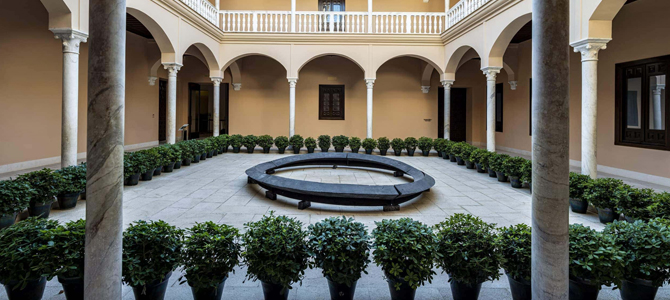
Bodega Bar El Pimpi
It is almost impossible to talk about Malaga without mentioning El Pimpi. This emblematic bar, located on Calle Granada, is much more than just a place for tapas: it is an authentic living Andalusian courtyard. From the fountain that welcomes customers to its corners full of history, El Pimpi will take you back to the mid-19th century, when patios were the centre of social life.
In addition to its unique atmosphere, El Pimpi is famous for its gastronomy and its wide selection of wines. An essential place to feel the pulse of the city.
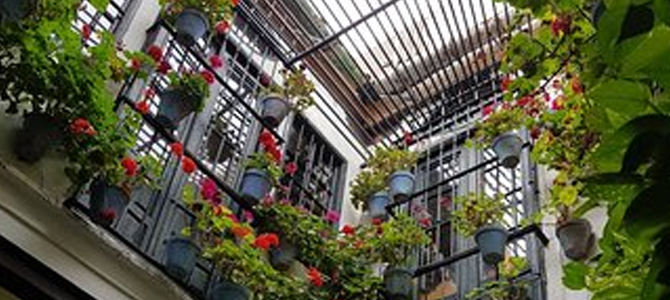
The Episcopal Palace
We end our tour at the Episcopal Palace, an imposing 18th century Baroque building located opposite the Cathedral of the Incarnation. This palace, declared an Asset of Cultural Interest, houses a spectacular courtyard with a central fountain on the ground floor.
Refurbished in the 1940s, this courtyard is a perfect example of how Andalusian architecture combines elegance and functionality. The palace also houses the Diocesan Museum of Sacred Art, making it an ideal visit for art and history lovers.
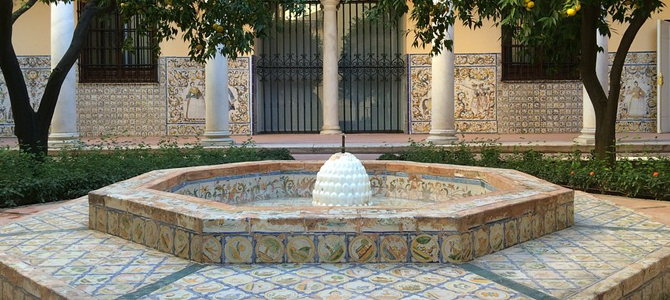
The Corralones of La Trinidad and El Perchel
If you visit Malaga in June, you can’t miss the Semana Popular de los Corralones de La Trinidad y El Perchel. This festival, similar to the famous Patios de Córdoba contest, is a celebration of Andalusian popular culture. During these days, the residents of these neighbourhoods open the doors of their houses to show off their courtyards, decorated with pots full of flowers and traditional elements.
The Semana Popular de los Corralones de La Trinidad y El Perchel is an emblematic event that celebrates the essence and tradition of these historic Malaga neighbourhoods. Under the slogan ‘#Somos Barrio, in the heart of Malaga’, this festival offers a programme full of activities for all ages, such as guided historical tours, free visits to the corralones, exhibitions, gastronomic exhibitions, workshops and performances.
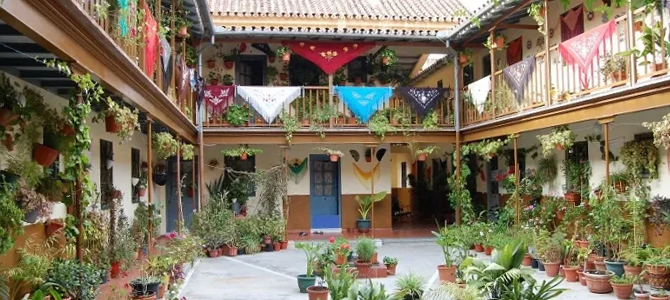
The heart of the event is the floral and traditional courtyard decoration contest, where neighbours showcase the life and customs that have endured in these community spaces. This celebration not only seeks to preserve Malaga’s popular culture, but also to promote and revitalise the neighbourhoods of La Trinidad and El Perchel as part of a social project of community intervention that takes place throughout the year.
The Semana Popular de los Corralones is a unique opportunity to immerse yourself in the authenticity of Malaga, discover its cultural heritage and enjoy the warmth of its neighbours. All the information about the activities is available on the website: www.somosbarrio.eu .
A real treasure in the city
Malaga’s patios are much more than a tourist attraction: they represent a way of life, a way of understanding architecture and coexistence that has endured for centuries. By visiting them, you will not only be contemplating spaces of great beauty, but also immersing yourself in the very essence of Mediterranean culture.
We invite you to discover Malaga from this different perspective, beyond the beach and conventional tourism. Lose yourself in its narrow streets, knock on the doors of the patios and let yourself be surprised by these hidden treasures that will show you the true soul of the city.


